Arcadyan Technology WA4001CB WLAN ACCESS POINT User Manual P74841 F5D7233 man indd
Arcadyan Technology Corporation WLAN ACCESS POINT P74841 F5D7233 man indd
Contents
USER MANUAL 1 OF 7

User Manual
F5D723
3
Share
your hotel broadband
Internet
connection
Wireless G
Travel Router
�
�

Table of Contents
3
1. Introduction
. . . . . . . . . . . . . . . . . . . . . . . . . . . . . . . . . . . . . . . . . . . .
1
Advantages of a Wireless Network
. . . . . . . . . . . . . . . . . . . . . . . . .
1
Placement of your Router for Optimal Performance
. . . . . . . . . . . . .
2
2. Product Overview
. . . . . . . . . . . . . . . . . . . . . . . . . . . . . . . . . . . . . . . .
6
Product Features
. . . . . . . . . . . . . . . . . . . . . . . . . . . . . . . . . . . . . . .
6
3. Knowing your Router
. . . . . . . . . . . . . . . . . . . . . . . . . . . . . . . . . . . . .
9
Package Contents
. . . . . . . . . . . . . . . . . . . . . . . . . . . . . . . . . . . . . .
9
System Requirements
. . . . . . . . . . . . . . . . . . . . . . . . . . . . . . . . . . .
9
Product
Diagrams
. . . . . . . . . . . . . . . . . . . . . . . . . . . . . . . . . . . . .
10
4. Connecting and Configuring your Router
. . . . . . . . . . . . . . . . . . . . .
12
Router Mode Installation
. . . . . . . . . . . . . . . . . . . . . . . . . . . . . . . .
13
Adapter Mode Installation
. . . . . . . . . . . . . . . . . . . . . . . . . . . . . . .
16
Access Point Mode Installation
. . . . . . . . . . . . . . . . . . . . . . . . . . .
18
5
. Using the Web-Based Advanced User Interface
. . . . . . . . . . . . . . . .
20
Logging into the Router
. . . . . . . . . . . . . . . . . . . . . . . . . . . . . . . . .
20
Logging out of the Router
. . . . . . . . . . . . . . . . . . . . . . . . . . . . . . .
21
Setting your Connection Type
. . . . . . . . . . . . . . . . . . . . . . . . . . . .
24
Setting Custom Domain Name Server (DNS) Settings
. . . . . . . . . .
30
Configuring your WAN Media Access Controller (MAC) Address
. .
30
Viewing
LAN Settings
. . . . . . . . . . . . . . . . . . . . . . . . . . . . . . . . . . .
32
Changing LAN Settings
. . . . . . . . . . . . . . . . . . . . . . . . . . . . . . . . .
33
Viewing the DHCP Client List Page
. . . . . . . . . . . . . . . . . . . . . . . .
35
Configuring the Wireless Network Settings
. . . . . . . . . . . . . . . . . .
36
Securing your Wi-Fi Network
. . . . . . . . . . . . . . . . . . . . . . . . . . . . .
37
WEP Setup
. . . . . . . . . . . . . . . . . . . . . . . . . . . . . . . . . . . . . . . .
42
Changing the Wireless Security Settings
. . . . . . . . . . . . . . . . .
44
WPA Setup
. . . . . . . . . . . . . . . . . . . . . . . . . . . . . . . . . . . . . . . .
44
WPA/WPA2 Setup
. . . . . . . . . . . . . . . . . . . . . . . . . . . . . . . . . .
4
5
Utilities Tab
. . . . . . . . . . . . . . . . . . . . . . . . . . . . . . . . . . . . . . . . . .
52
Restarting the Router
. . . . . . . . . . . . . . . . . . . . . . . . . . . . . . . .
53
Updating the Firmware
. . . . . . . . . . . . . . . . . . . . . . . . . . . . . . .
58
6
. Manually Configuring Network Settings
. . . . . . . . . . . . . . . . . . . . .
62
7
. Recommended Web Browser Settings
. . . . . . . . . . . . . . . . . . . . . . .
6
4
8
.
Using the Access Point Mode
. . . . . . . . . . . . . . . . . . . . . . . . . . . . . .
6
6
9
.
Using the Adapter Mode
. . . . . . . . . . . . . . . . . . . . . . . . . . . . . . . . . .
67
10.
Troubleshooting
. . . . . . . . . . . . . . . . . . . . . . . . . . . . . . . . . . . . . . .
7
3
11.
Information
. . . . . . . . . . . . . . . . . . . . . . . . . . . . . . . . . . . . . . . . . .
8
0

Thank you for purchasing the Belkin Wireless G Travel Router (the
Router). Please be sure to read through this User Manual completely, and
pay special attention to the section entitled “Placement of your Router
for Optimal Performance” on page 2.
Advantages of a Wireless Network
•
Mobility
–
you no longer need a dedicated “computer
room”—now you can work on a networked laptop or desktop
computer anywhere within your wireless range
•
Easy installation
–
The Belkin Easy Installation Wizard makes
setup simple
•
Flexibility
–
set up and access printers, computers, and other
networking devices from anywhere in your home
•
Easy expansion
–
the wide range of Belkin networking products
let you expand your network to include devices such as printers
and gaming consoles
•
No cabling required
–
you can spare the expense and hassle of
retrofitting Ethernet cabling throughout the home or office
•
Widespread industry acceptance
–
choose from a wide range
of interoperable networking products
Introduction
2
1
3
4
5
6
7
8
9
10
11
section
1

2
Introduction
Introduction
Placement of your Router for Optimal Performance
Important Factors for Placement and Setup
Your wireless connection will be stronger the closer your computer is
to your Router. Typical indoor operating range for wireless devices is
between 100 and 200 feet.
In the same way, your wireless connection and performance will
degrade somewhat as the distance between your Router and
connected devices increases. This may or may not be noticeable
to you. As you move farther from your Router, connection speed
may decrease. Factors that can weaken signals simply by getting
in the way of your network’s radio waves are metal appliances or
obstructions, and walls.
If you have concerns about your network’s performance that might be
related to range or obstruction factors, try moving the computer to a
position between five and 10 feet away from the Router in order to see
if distance is the problem. If difficulties persist even at close range,
please contact Belkin Technical Support.
Note:
While some of the items listed below can affect network
performance, they will not prohibit your wireless network from
functioning; if you are concerned that your network is not operating at
its maximum effectiveness, this checklist may help.
1.
Wireless Router Placement
Place your
R
outer
, the central connection point of your network,
as close as possible to the center of your wireless
network devices.
To achieve the best wireless network coverage for your “wireless
clients” (i.e., computers enabled by Belkin Wireless Notebook
Network Cards, Wireless Desktop Network Cards, and Wireless
USB Adapters):
• Ensure that your
R
outer’s
networking
antennas are parallel
to each other, and are positioned vertically (toward the
ceiling). If your
Router
itself is positioned vertically, point the
antennas as much as possible in an upward direction.
•
In multistory homes, place the
R
outer
on a floor that is as
close to the center of the home as possible. This may mean
placing the
R
outer
on an upper floor.
• Try not to place the
R
outer
near a
cordless phone.

Introduction
Introduction
3
Introduction
2
1
3
4
5
6
7
8
9
10
11
section
2. Avoid Obstacles and Interference
Avoid placing your
R
outer
n
ear devices that may emit radio
“noise,” such as microwave ovens. Dense objects that can inhibit
wireless communication include:
• Refrigerators
• Washers and/or dryers
• Metal cabinets
• Large aquariums
• Metallic-based, UV-tinted windows
If your wireless signal seems weak in some spots, make sure that
objects such as these are not blocking the signal’s path (between
your computers and Router).
3.
Cordless Phones
If the performance of your wireless network is impaired after
attending to the above issues, and you have a cordless phone:
• Try moving cordless phones away from the Router and your
wireless-enabled computers.
• Unplug and remove the battery from any cordless phone
that operates on the 2.4GHz band (check the manufacturer’s
information). If this fixes the problem, your phone may
be interfering.
• If your phone supports channel selection, change the
channel on the phone to the farthest channel from your
wireless network. For example, change the phone to channel
1 and move your Router to channel 11. See your phone’s user
manual for detailed instructions.
• If necessary, consider switching to a 900MHz cordless phone.
4.
Choose the “Quietest” Channel for your Wireless Network
In locations where homes or offices are close together, such as
apartment buildings or office complexes, there may be wireless
networks nearby that can conflict with yours.
Use the Site
Survey capabilities found in the wireless utility
of your wireless adapter or card to locate any other wireless
networks that are available (see your wireless adapter’s
or card
’s
user manual), and move your Router and computers to a channel
as far away from other networks as possib
le.

4
Introduction
Introduction
•
Experiment with more than one of the available channels in
order to find the clearest connection and avoid interference
from neighboring cordless phones or other wireless devices.
•
For Belkin wireless networking products, use the detailed Site
Survey and wireless channel information
included with your
Wireless Network Card. See your Network Card’s user guide
for more information.
These guidelines should allow you to cover the maximum
possible area with your Router. Should you need to cover an
even wider area, we suggest the Belkin Wireless G Range
Extender/Access Point.
5. Secure Connections, VPNs, and AOL
Secure connections typically require a user name and password,
and are used where security is important. Secure
connections include:
• Virtual Private Network (VPN) connections, often used to
connect remotely to an office network
• The “Bring Your Own Access” program from America Online
(AOL), which lets you use AOL through broadband provided by
another cable or DSL service
• Most online banking websites
• Many commercial websites that require a user name and
password to access your account
Secure connections can be interrupted by a computer’s power
management setting, which causes it to “go to sleep.” The
easiest solution to avoid this is to simply reconnect by
rerunning the VPN or AOL software, or by re-logging into
the secure website.
A second alternative is to change your computer’s power
management settings so it does not go to sleep; however, this
may not be appropriate for portable computers. To change your
power management setting under Windows
®
, see the “Power
Options” item in the Control Panel.
If you continue to have difficulty with secure connections, VPNs,
and AOL, please review the steps above to be sure you have
addressed these issues.

Introduction
Introduction
5
Introduction
2
1
3
4
5
6
7
8
9
10
11
section
For more information regarding our networking products, visit our website
at
www.belkin.com/networking
or call Belkin Technical Support at:
US: 877-736-5771
310-898-1100 ext. 2263
Europe: 00 800 223 55 460
Australia: 1800 235 546
New Zealand: 0800 235 546
Singapore: 800 616 1790

6
Product Overview
Product Features
In minutes you will be able to share your Internet connection and
network your computers. The following is a list of features that
make your new Belkin Wireless G Travel Router an ideal solution for
your home or small office network.
Works with PC Computers
The Router supports a variety of networking environments, including
Windows 98, Me, 2000, and XP. All you need is an Internet browser
and a network adapter that supports TCP/IP (the standard language
of the Internet).
Front-Panel LED Display
Lighted LEDs on the front of the Router indicate which functions
are in operation. You’ll know at-a-glance whether your Router is
connected to the Internet. This feature eliminates the need for
advanced software and status-monitoring procedures.
Web-Based Advanced User Interface
You can set up the Router’s advanced functions easily through your
web browser, without having to install additional software onto the
computer. There are no disks to install or keep track of and, best
of all, you can make changes and perform setup functions from any
computer on the network quickly and easily.
NAT IP Address Sharing
Your Router employs Network Address Translation (NAT) to share the
single IP address assigned to you by your Internet Service Provider
while saving the cost of adding IP addresses to your Internet
service account.
SPI Firewall
Your Router is equipped with a firewall that will protect your network
from a wide array of common hacker attacks, including IP Spoofing,
Land Attack, Ping of Death (PoD), Denial of Service (DoS), IP with
zero length, Smurf Attack, TCP Null Scan, SYN flood, UDP flooding,
Tear Drop Attack, ICMP defect, RIP defect, and fragment flooding.

Product Overview
7
2
1
3
4
5
6
7
8
9
10
11
section
Integrated 10/100 4-Port Switch
The Router has a built-in, 4-port network switch to allow your wired
computers to share printers, data and MP3 files, digital photos,
and much more. The switch features automatic detection so it will
adjust to the speed of connected devices. The switch will transfer
data between computers and the Internet simultaneously without
interrupting or consuming resources.
Universal Plug-and-Play (UPnP) Compatibility
UPnP (Universal Plug-and-Play) is a technology that offers seamless
operation of voice messaging, video messaging, games, and other
applications that are UPnP-compliant.
Support for VPN Pass-Through
If you connect to your office network from home using a VPN
connection, your Router will allow your VPN-equipped computer to
pass through the Router and to your office network.
Built-In Dynamic Host Configuration Protocol (DHCP)
Built-In Dynamic Host Configuration Protocol (DHCP) on-board makes
for the easiest possible connection of a network. The DHCP server
will assign IP addresses to each computer automatically so there is
no need for a complicated networking setup.
Easy Install Wizard
The Easy Install Wizard takes the guesswork out of setting up your
Router. This automatic software determines your network settings for
you and sets up the Router for connection to your Internet Service
Provider (ISP). In a matter of minutes, your Wireless Router will be up
and running on the Internet.
NOTE:
Easy Install Wizard software is compatible with Windows
98SE, Me, 2000, and XP.

8
Product Overview
MAC Address Filtering
For added security, you can set up a list of MAC addresses (unique
client identifiers) that are allowed access to your network. Every
computer has its own MAC address. Simply enter these MAC
addresses into a list using the Web-Based Advanced User Interface
and you can control access to your network.

9
section
2
1
3
4
5
6
7
8
9
10
11
Package Contents
• Wireless G Travel Router
•
Quick Installation Guide
•
Installation Software CD
•
Power Supply
•
USB Power Cable
•
Ethernet Cable
System Requirements
• PC-compatible laptop
•
Windows
98, Me, 2000, or XP
Knowing your Router
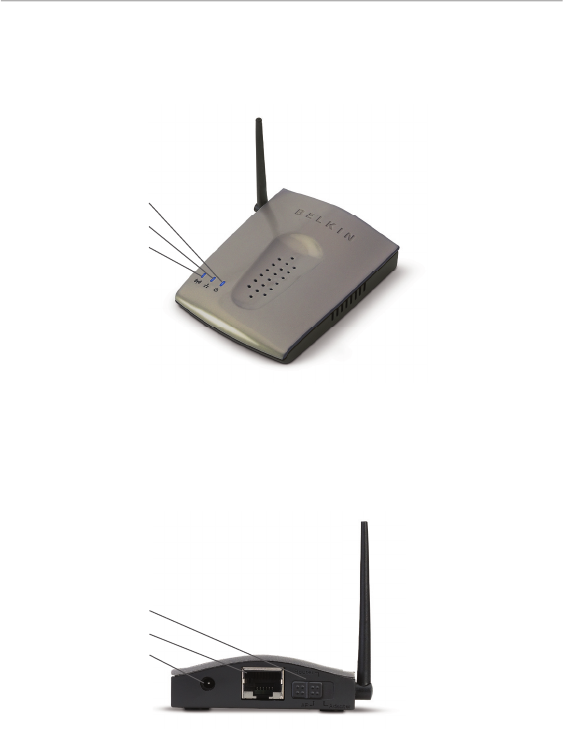
10
Knowing your Router
Knowing your Router
Product
Diagram
s
Top
A. Wireless LED
B. Ethernet LED
C. Power LED
Rear Panel
A. Power Cable Port
B. Ethernet Cable Port
C. Mode Switch
(C)
(B)
(A)
(C)
(B)
(A)
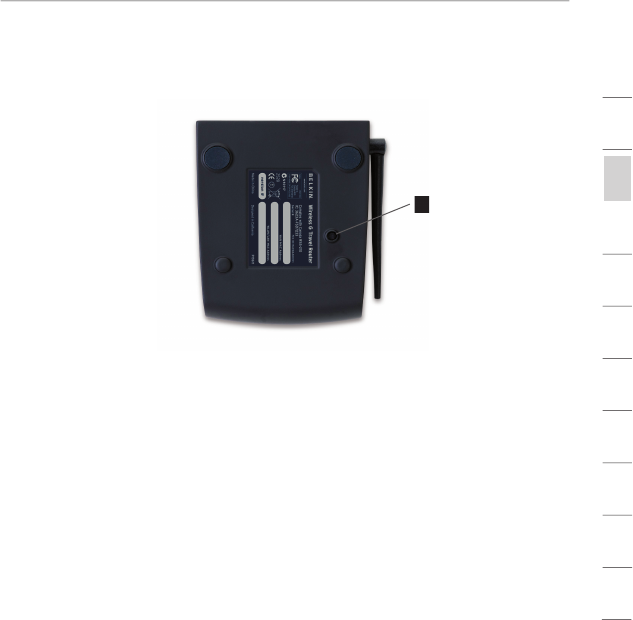
Knowing your Router
11
section
2
1
3
4
5
6
7
8
9
10
11
Bottom
A. Reset Button
(A)
(A)
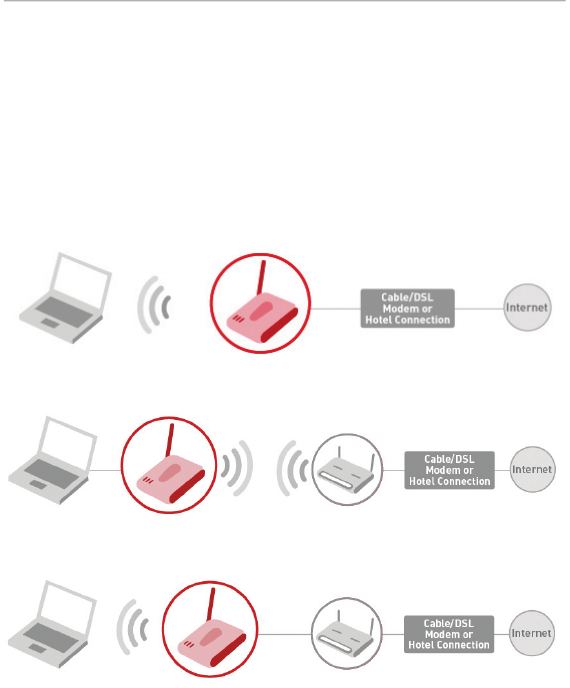
12
Connecting and Configuring your Router
The Belkin Wireless G Travel Router is a 3-in-1 solution providing the
busy traveler the versatility to meet his or her connection needs. The
three installation modes are:
Installation Modes
Router Mode
– create a wireless network in a hotel, home, or office
Adapter Mode
– connect your PC wirelessly to a router or hotspot
Access Point Mode
– expand the coverage of an existing network
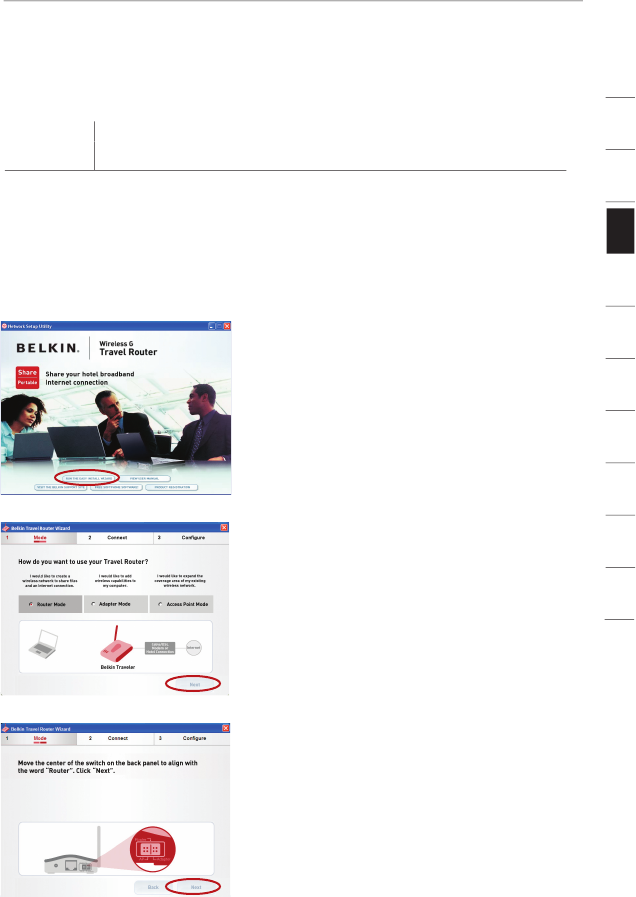
Connecting and Configuring your Router
13
section
2
1
3
4
5
6
7
8
9
10
11
Router Mode
Installation
1. Install Run the Easy Install Wizard first!
DO NOT CONNECT THE ROUTER AT THIS TIME.
Important for Hotel Users:
Do not connect to the hotel’s high-speed Internet connection at
this time (to avoid being charged more than once).
1. Install Run the Easy Install Wizard first!
1.
1
Insert the Installation CD into
your CD-ROM drive. You will see
the Wizard’s welcome screen. Click
“Run the Easy Install Wizard”.
1.2
The Easy Install Wizard will ask
you to select which mode you want
the Router to use. Select “Router
Mode”, and click “Next”.
1.3
The next screen will show you how
to select the mode on the Router’s
back panel. Move the center of
the button on the back panel to
align with the word “Router”. Then,
click “Next”.
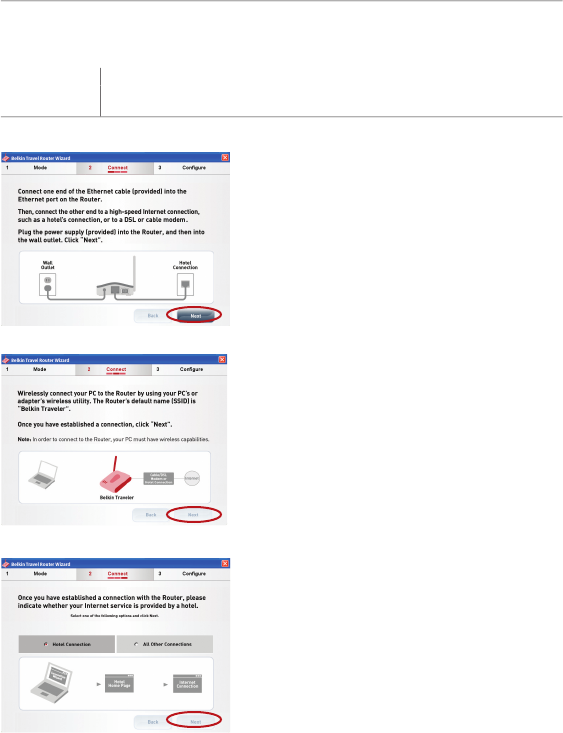
14
Connecting and Configuring your Router
Connecting and Configuring your Router
2.1
Connect one end of the included
Ethernet cable into the Router and
the other end into a hotel’s Internet
connection or a cable/DSL modem.
Next, plug the included power
supply into the Router, and then
click “Next”.
2
. Connect Connecting the Router’s Cables
. Connect Connecting the Router’s Cables
2.2
From your PC, wirelessly connect
to the Router using your PC’s
built-in wireless card or external
wireless adapter. The network
name (SSID) of the Router is
“Belkin Traveler”. Once you have
connected wirelessly, click “Next”.
2.3
Select one of the following:
Hotel Connection
– Select “Hotel
Connection” if you are in a hotel.
CLICK “NEXT” AND FOLLOW THE
INSTRUCTIONS IN STEP 3.
Cable/DSL Connection
– If you
are using a cable/DSL modem,
select “All Other Connections”.
CLICK “NEXT” AND FOLLOW THE
INSTRUCTIONS IN STEP 4.
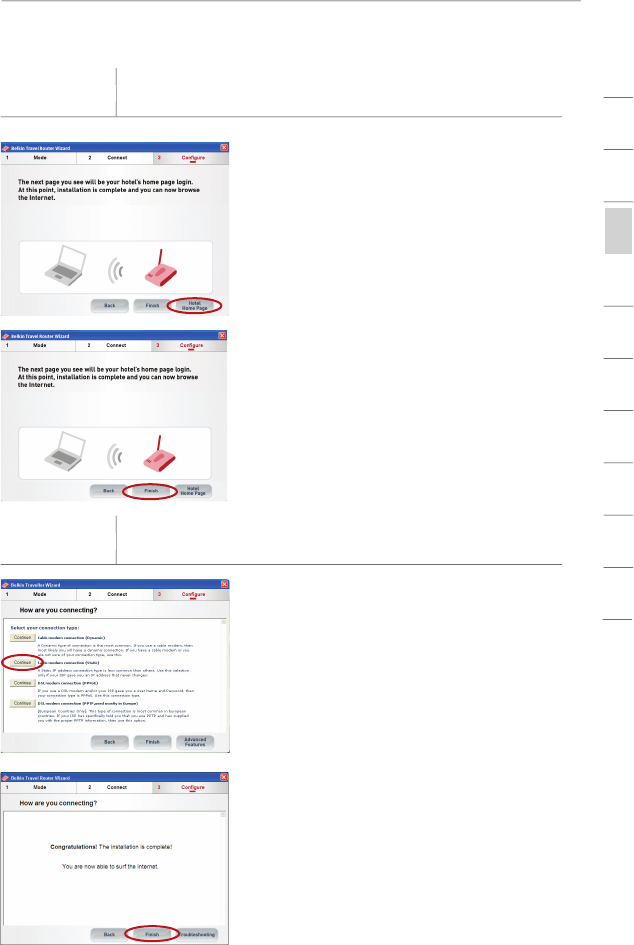
Connecting and Configuring your Router
15
section
2
1
3
4
5
6
7
8
9
10
11
3.1
Click the “Hotel Home Page”
button to open up a web browser
and set up the hotel’s connection.
You may be required to accept the
terms of the hotel’s high-speed
Internet connection in order to
access the Internet.
3
. Configure Hotel Users - Configuration for Hotel Connections
. Configure Hotel Users - Configuration for Hotel Connections
3.2
Your installation is now complete.
However, if you would like to
set up any advanced features
(such as security features), you
may click the “Advanced Features”
button or type “192.168.2.1”
into the navigation bar of your
web browser. Click “Finish”.
4.1
Select one of the following Internet
connection options under “Cable or
DSL modem”. Select your Internet
connection and click “Continue”.
Note:
If you do not see the page
pictured here, open a web browser.
Once you have established a connection
with the Router, type “192.168.2.1” into
the navigation bar of your web browser.
4.2
Your installation is now complete.
However, if you would like to set
up any advanced features (such as
security features), you may click the
“Advanced Features” button or type
“192.168.2.1” into the navigation bar
of your web browser. Click “Finish”.
4
. Configure
Cable/DSL Users - Configuration for Cable/DSL Connections
. Configure